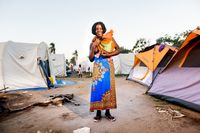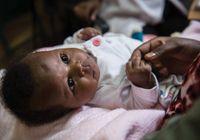
Photo credits: IPPF
In addition to the inclusion of newborn health in the RHAabbreviation (Section 4.1.1), undertaking a situation analysis is important to develop a comprehensive understanding of newborn health related needs, services, programs and gaps in the crisis-affected setting. In addition to the actions outlined below, it is important to work with the SRHabbreviation coordinator and SRHabbreviation partners to identify and address local political and governance barriers as part of the situational analysis in order to facilitate program implementation. The security situation should be assessed, including security risks and safety issues that may impact travel and service delivery for pregnant and postnatal women. Population movements, malnutrition, food security and water scarcity are common in humanitarian settings and should be taken into consideration as they impact maternal and newborn survival.
4.2.1 Examine national policies and protocols relevant to newborn health
- Carefully examine the existing national policies and protocols related to SRHabbreviation including newborn care, to ensure they align with WHOabbreviation guidance.
- If national policies related to newborn care are lacking, use WHOabbreviation guidance.info
- Where discrepancies between national and WHOabbreviation protocols are identified, raise these in the SRHabbreviation working group meetings to address with government, UNabbreviation and other partners.
- If the SRHabbreviation working group is unable to facilitate alignment between national and international MNHabbreviation standards, raise the issue in a health sector/cluster meeting and request WHOabbreviation to initiate and facilitate a dialogue with appropriate government ministries.
- Avoid reinventing programs and protocols that already exist, or developing new recommendations that may conflict with current standards.
4.2.2 Examine existing clinical guidelines, key messages/ BCC materials, tools and training materials
- Similarly, examine the clinical guidelinesinfo currently in place for newborn care within the country’s health facilities to ensure that they are up to date, and review the behavior change communication (BCCabbreviation) materials used to communicate with women, families and communities about ENCabbreviation and newborn danger signs (see Section 5.1).
- Assess the availability and appropriateness of tools and training, including on RMCabbreviation,info available for health personnel.
- Update these clinical resources as needed, and prioritize dissemination to humanitarian response partners, including governmental ministries, UNabbreviation organizations, INGOs and local NGOs.
- Be sure to respect and work within national health policies.
Note that the MISPabbreviation does not include undertaking assessments until the situation has stabilized. However, where a situation analysis is conducted at the onset of a SRMNH response; newborn care should be included. For more information, see the chapter 3 and 5 of the Inter-agency Field Manual on Sexual and Reproductive Health in Humanitarian Settings (2018).
Box 4.3: Planning and delivering coordinated health services
Avoid creating health program “silos”, in which information is collected through separate entities rather than a unified system. Information about newborn health services should be collected in coordination with sexual and reproductive or broader health assessments to maximize the coordination of health care delivery.
4.2.3 Assess resource availability: facilities, supplies and staff
Facility
- Work closely with the health sector/cluster and SRH working group to ensure that newborn health is integrated into any health facility assessment.
- Identify existing/functioning health facilities, highlighting which facilities deliver newborn health services, facility capacity, and which ones require additional inputs as part of a newborn health service expansion plan.
- If the crisis-affected area contains multiple communities, or an entire country, assess facility and service availability for each locality based on national or traditional community divisions.
- If feasible, map the existing facilities and/or programs, to form part of the basis for service planning, and examine community access to and utilization of these available health services. Ensure the inclusion of community-based facilities in this mapping.
Annex 6A provides a list of indicators to be collected through routine data systems. Annex 6B presents a list of indicators and questions to measure facility capacity to provide ENC and key interventions to address the major causes of newborn deaths.
Supplies
- Once a clear picture of the facilities has been established, use the comprehensive newborn supply kit list (see Annex 5) to assess the availability of medicines and medical supplies within each facility.
- Take note of facilities that appear particularly well equipped to provide SRH care and could serve as effective referral sites for newborns in danger.
- If facilities lack essential supplies, help staff to procure the needed medicines, medical commodities and supplies.
Staff
- Assess staff availability and competencies at the facility or community level.
- Assess the number and type of skilled health care providers available in each locality and identify where they work, e.g., within a mobile clinic, as outreach workers, within an existing health center or in a temporary clinic set up by an NGO to respond to the crisis.
- Once an estimate of the number of providers has been established, evaluate provider competencies to deliver SRH care. Assess providers of all backgrounds – physicians, nurses, midwives, traditional birth attendants, CHWsabbreviation, etc.
- Ensure that staff are prepared to provide antenatal and postnatal care for newborns, and to transition babies and their mothers into MNCH care following the neonatal period.
Include the following considerations in your resource availability assessment:
- Distances from each affected community to various types of local health facilities that offer ENCabbreviation (existing/permanent clinics and hospitals, mobile clinics, temporary clinics);
- Distances from primary care facilities of various types to district hospitals with more advanced newborn care capabilities, including CEmONCabbreviation;
- Feasible transport options to cover these distances that are accessible to pregnant and postnatal women;
- Functioning communication systems, including cell phone coverage;
- Staff to patient ratios (e.g., numbers of physicians, nurses, etc., per newborn) in functioning facilities;
- Availability of protocols for managing newborn referrals at the facility level, and
- Security risks and safety issues that may impact travel and service delivery for pregnant and postnatal women.
The information gathered during this process will not only contribute to a comprehensive picture of available SRHabbreviation care in the affected region, but a comprehensive map of newborn health service availability will also begin to emerge. This will inform the development of training programs for health workers and professional medical staff and serve as the basis for the newborn referral network (Section 5.2).
Box 4.4: Case Study: working with the local government and communities during the earthquake in Nepal
In April 2015, a devastating earthquake struck Nepal, destroying or damaging more than 1000 health facilities. Pregnant women and families with newborns didn’t know which health facilities were functional, sometimes traveling very far to receive care. Transport costs were also prohibitive for many families.
Save the Children worked with local government authorities in 31 villages across 5 districts to address some of the key barriers to accessing maternal and newborn care. In coordination with the local Health Facility Management Committees and health facilities themselves, they mapped and helped strengthen the existing newborn health services. To raise awareness among affected communities, local partners developed pictorial posters, crafted radio jingles and engaged female health volunteers to hold discussions in the community about where, why and how to access newborn care from the closest facility. As a result of these and other efforts, utilization of facility-based maternal and newborn health services increased significantly.
Save the Children also piloted an innovative seed fund to support maternal and newborn transport and referral in the district of Dolakha. In partnership with local Village Development Committees and health facilities, they established a community owned fund to provide financial support for families in need of immediate referral. Community health workers conducted awareness-raising with families on the availability of the funds, on newborn danger signs and the importance of facility-based delivery. Although some fund managers were hesitant to provide cash assistance for fears of being accused of corruption, the project helped a number of women and newborns access life-saving care.

